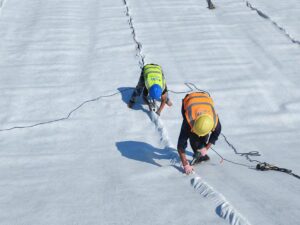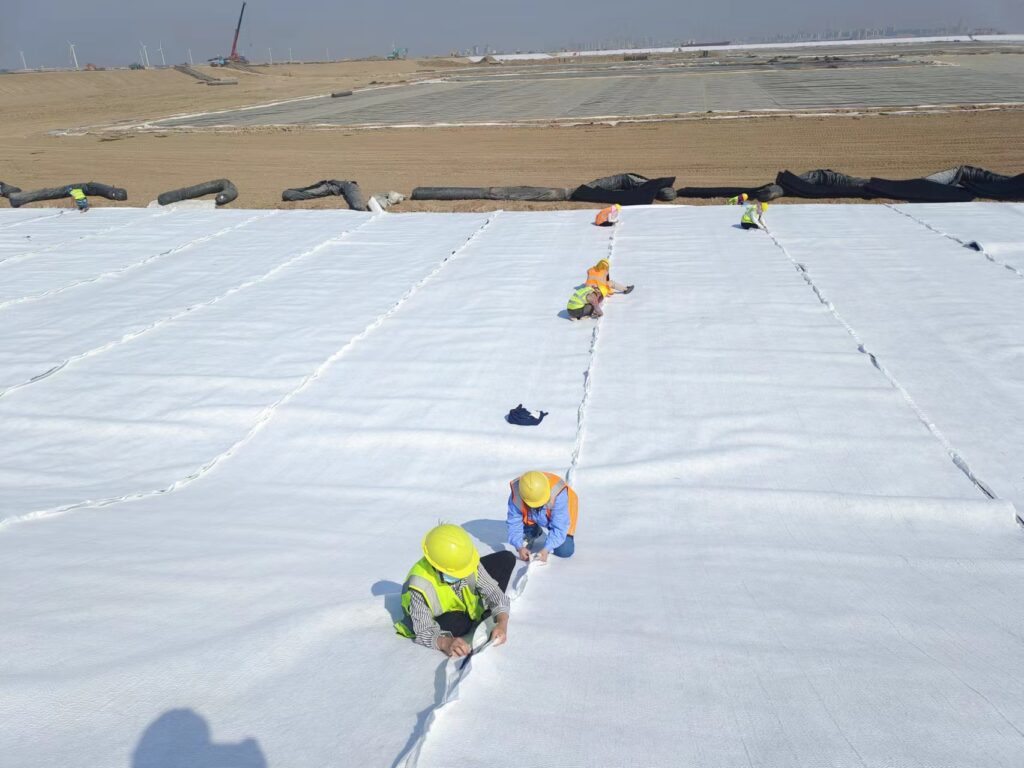Geotextile cutting tools
Scissors: For thinner and softer geotextiles, regular household scissors will usually do the job well. Make sure to use sharp scissors to get clean and accurate cutting edges.
Knives: Knives, such as utility knives, cutting knives, or secant knives, can be used to cut geotextiles. Make sure the blade is sharp and use a straight or wavy blade to get the desired cut.
Cutting Machine: For larger geotextile projects that require frequent cutting, it may be more efficient to use a cutting machine. Cutter machines typically feature sharp rotating blades with adjustable cutting depth and cutting width.
Thermal Cutting Tools: In some cases where complete sealing or precise cutting of geotextiles is required, thermal cutting tools such as a thermal cutting knife or thermal cutter can be used. These tools use a high-temperature heat source, such as a hot knife or hot wire, to cut the geotextile and weld it while cutting, preventing disintegration and peeling of the edges.
Please note that before using any geotextile cutting tool, always take safety measures, such as wearing appropriate protective gloves and eye protection, and operating on a stable work surface to prevent accidental injury.
Additionally, selecting the appropriate cutting tool depends on the geotextile type, thickness and desired cutting effect, so it is recommended to select the correct tool for cutting based on specific project needs.

Geotextile joint material
Hot-melt Tape: Hot-melt Tape is a special tape that is connected to the geotextile by applying heat. When heat is applied, the hot melt tape melts and adheres to the geotextile surface, forming a strong bonded joint. This is a commonly used geotextile joint material widely used in civil engineering and environmental engineering.
Hot Wedge Welding: Hot Wedge Welding is a method that uses heat to heat the geotextiles at the joints to a molten state and fuse them with each other. This method is often used on large geotextile projects, such as joints for waterproofing layers. By heat welding, strong, seamless seams are created.
Cold Adhesive: Cold Adhesive is a special adhesive suitable for connecting geotextiles. It usually comes in liquid or paste form and needs to be applied to the joints and then allowed to dry and cure over a certain period of time. Cold adhesive provides strong joints and can be adapted to different types of geotextiles.
Stitching: For some types of geotextiles, such as thicker or harder materials, stitching can be used to sew the seams together. This method is often used for edge seams or seams in special projects.
Interlocking Profiles: Interlocking profiles are a special design element used to connect geotextiles. These posts can be embedded into the seams of the geotextile and provide a reliable joint through an interlocking design.
Selecting the appropriate geotextile joint material depends on the specific needs of the project, the type of geotextile and the application environment.
Before jointing, be sure to follow the manufacturer’s recommendations and instructions, correctly select and use jointing materials, and follow correct jointing methods and procedures to ensure the strength and sealing of the joint.
Geotextile measuring tools
Measuring Ruler: Measuring ruler is one of the basic tools for geotextile measurement. By placing a measuring ruler on the geotextile and reading the corresponding scale, the size, length, width, and other dimensional parameters of the geotextile can be measured.
Liquid measuring instruments: For applications that require accurate measurement of geotextile weight or area covered, liquid measuring instruments, such as weighing scales or level gauges, can provide more precise measurements.
Optical measuring instruments: Optical measuring instruments, such as laser rangefinders or optical projection measuring instruments, can be used to measure the length, width and height of geotextiles. These instruments use optical principles to quickly and accurately measure geotextile dimensions.
Electronic Distance Meter: An electronic distance meter is a portable device that uses ultrasonic or laser measurement technology to measure distances across geotextiles. By measuring the distance of the sound waves or light beams projected by the geotextile, more accurate dimensional data can be obtained.
Light transmittance meter: The light transmittance meter is used to measure the light transmission performance of geotextiles. This tool evaluates the ability of a geotextile to penetrate light and is useful in applications where light is blocked or controlled.
Expansion rate tester: The expansion rate tester is used to measure the elongation performance of geotextiles. By applying force and measuring the elongation of the geotextile, the ductility of the geotextile during construction or use can be evaluated.
Listed above are some common geotextile measurement tools that can meet different measurement and evaluation needs. Depending on the specific application and measurement requirements, choosing the right tools for geotextile measurement can improve measurement accuracy and work efficiency.


